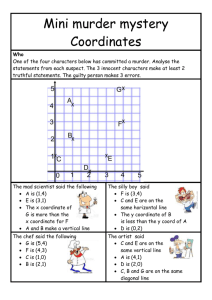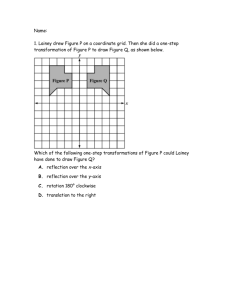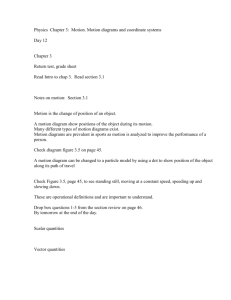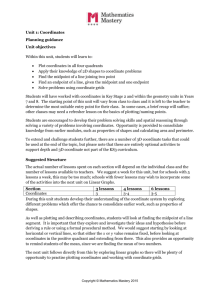Orthogonal Coordinate Transformation Summary Orthogonal
advertisement
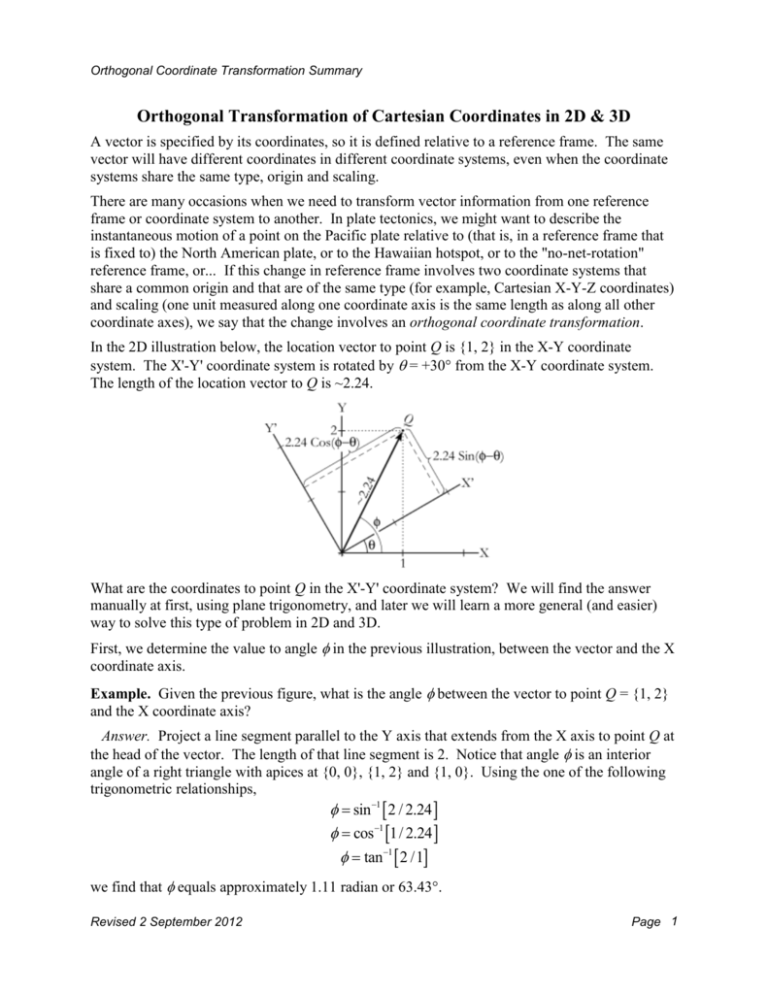
Orthogonal Coordinate Transformation Summary
Orthogonal Transformation of Cartesian Coordinates in 2D & 3D
A vector is specified by its coordinates, so it is defined relative to a reference frame. The same
vector will have different coordinates in different coordinate systems, even when the coordinate
systems share the same type, origin and scaling.
There are many occasions when we need to transform vector information from one reference
frame or coordinate system to another. In plate tectonics, we might want to describe the
instantaneous motion of a point on the Pacific plate relative to (that is, in a reference frame that
is fixed to) the North American plate, or to the Hawaiian hotspot, or to the "no-net-rotation"
reference frame, or... If this change in reference frame involves two coordinate systems that
share a common origin and that are of the same type (for example, Cartesian X-Y-Z coordinates)
and scaling (one unit measured along one coordinate axis is the same length as along all other
coordinate axes), we say that the change involves an orthogonal coordinate transformation.
In the 2D illustration below, the location vector to point Q is {1, 2} in the X-Y coordinate
system. The X'-Y' coordinate system is rotated by = +30° from the X-Y coordinate system.
The length of the location vector to Q is ~2.24.
What are the coordinates to point Q in the X'-Y' coordinate system? We will find the answer
manually at first, using plane trigonometry, and later we will learn a more general (and easier)
way to solve this type of problem in 2D and 3D.
First, we determine the value to angle in the previous illustration, between the vector and the X
coordinate axis.
Example. Given the previous figure, what is the angle between the vector to point Q = {1, 2}
and the X coordinate axis?
Answer. Project a line segment parallel to the Y axis that extends from the X axis to point Q at
the head of the vector. The length of that line segment is 2. Notice that angle is an interior
angle of a right triangle with apices at {0, 0}, {1, 2} and {1, 0}. Using the one of the following
trigonometric relationships,
f = sin-1 [ 2 / 2.24 ]
f = cos-1 [1/ 2.24 ]
f = tan -1 [ 2 /1]
we find that equals approximately 1.11 radian or 63.43°.
Revised 2 September 2012
Page 1
Orthogonal Coordinate Transformation Summary
Second, project a line perpendicular to the X' axis that passes through point Q. Notice the right
triangle with apices {0, 0}, {1, 2} and the intersection of axis X' and the line you just
constructed. At the origin, one of the interior angles of that right triangle is the difference
between angles and .
Example. What are the respective lengths of the opposite (O) and adjacent (A) sides of the right
triangle whose hypotenuse is equal to
12 + 2 2 » 2.24 and where the relevant interior angle is
(–) = 63.43°–30° = 33.43°.
Answer. Recalling the trigonometric relationship O = H sin(–),
O = 2.24 sin(33.43°) = 1.23
Similarly, recalling that A = H cos(–),
A = 2.24 cos(33.43°) = 1.87
The coordinates of the vector to point Q in the original X-Y coordinate system are {1, 2}. In the
X'-Y' coordinate system with the same origin as the X-Y coordinate system but which is rotated
30° anti-clockwise from the X-Y system, the coordinates of the vector to Q are {1.87, 1.23}.
Now that we know how to multiply a 3x1 vector matrix by a 3x3 matrix (or a 2x1 vector matrix
by a 2x2 matrix, for the 2 dimensional case), we can take advantage of a simpler and more
general way to solve this kind of problem. We start by calling the unit vectors along the original
X, Y and Z axes i, j and k, respectively. In a similar manner, we call the unit vectors along the
new X, Y and Z axes i', j' and k', respectively. Using these unit vectors, we can define a 3
dimensional transformation matrix J3D as follows
J 3D
é
ê
=ê
ê
ê
ë
iˆ '× iˆ
ĵ '× iˆ
iˆ '× ĵ
ĵ '× ĵ
k̂ '× iˆ k̂ '× ĵ
iˆ '× k̂ ù
ú
ĵ '× k̂ ú
ú
k̂ '× k̂ ú
û
The first row in the transformation matrix includes the coordinates of the iˆ ' unit vector (which is
along the new X' axis) along the original X, Y and Z coordinate axes, respectively. The second
row is the projection of the ĵ ' vector along the original coordinate axes, and the third row is the
projection of the k̂ ' vector along the original coordinate axes.
The 2-dimensional version of the transformation matrix is J2D, where
J2 D
Revised 2 September 2012
é iˆ '× iˆ iˆ '× ĵ
=ê
ê ĵ '× iˆ ĵ '× ĵ
ë
ù
ú
ú
û
Page 2
Orthogonal Coordinate Transformation Summary
If a new coordinate system X'-Y'-Z' is rotated by a positive angle (anti-clockwise) relative to
the original coordinate system X-Y-Z, where both coordinate systems share a common origin,
the transformation matrix is
é cosq sinq ù
J2 D = ê
ú
ë - sinq cosq û
The matrix equation that gives us the coordinates of a vector in a new coordinate system rotated
by an angle of from the original coordinate system is
é x ' ù é cosq
ê
ú=ê
êë y' úû ë - sinq
sinq ù é x ù
ú
úê
cosq û êë y úû
where {x, y} are the coordinates in the original coordinate system and {x', y'} are the coordinates
in the new coordinate system.
Example. If the coordinates of a vector in one coordinate system are {1, 2}, what are the
coordinates of that vector in a new coordinate system with the same origin and that is rotated
+30° (anti-clockwise) from the original coordinate system?
Answer. Given
é x ' ù é cosq sinq ù é
ê
ú=ê
úê
êë y' úû ë - sinq cosq û êë
where {x, y} = {1, 2} and = 30°,
é x ' ù é cos(30°) sin(30°)
ê
ú=ê
êë y' úû êë - sin(30°) cos(30°)
which can be unpacked into parametric equations as follows:
x ù
ú
y úû
ùé 1 ù
úê
ú
úû ë 2 û
x' = ((1) cos(30°)) + ((2) sin(30°)) = 1.87
y' = ((1) (–sin(30°))) + ((2) cos(30°)) = 1.23.
So {x', y'} = {1.87, 1.23}.
Revised 2 September 2012
Page 3
Orthogonal Coordinate Transformation Summary
We had already proven that a vector with coordinates {1, 2} in one coordinate system has
coordinates {1.87, 1.23} in a coordinate system rotated 30° from original, so now we have
duplicated that result using a transformation matrix. Now that we have this tool, we can use it to
quickly find the new coordinates of any vector whose coordinates are known in the original
coordinate system. And we can find the coordinates of any vector in any coordinate system that
shares an origin with our original coordinate system, so long as we know the angular relationship
of the new coordinate axes to the original coordinate axes.
Example. Given the following unit vectors along an initial set of coordinate axes (X-Y-Z),
iˆ = {1, 0, 0}, ĵ = {0, 1, 0} and k̂ = {0, 0, 1},
and the following unit vectors along a new set of coordinate axes (expressed relative to the initial
coordinate system and rounded to four places past the decimal),
iˆ ' = {0.6409, -0.7604, -0.1056},
ĵ ' = {0.6409, 0.6057, -0.4717}, and
k̂ ' = {0.4226, 0.2346, 0.8754}.
Use the appropriate dot products to find the transformation matrix to go from the initial
coordinates to the new coordinates, and find the new coordinates of the vector {2, 3, 1}.
Answer. We need to solve the following equation for {x', y', z'} given {x, y, z} = {2, 3, 1}:
é
é x ' ù ê iˆ '× iˆ iˆ '× ĵ
ê
ú ê
ˆ
ê y' ú = ê ĵ '× i ĵ '× ĵ
êë z' úû ê k̂ '× iˆ k̂ '× ĵ
ë
iˆ '× k̂ ù é x
ú
ê
ĵ '× k̂ ú ê y
ú
k̂ '× k̂ ú êë z
û
ù
ú
ú.
úû
Computing all of the dot products and rounding to four places past the decimal gives us
é x ' ù é 0.6409 -0.7604 -0.1056 ù é 2 ù
ê
ú ê
ú
úê
ê y' ú = ê 0.6409 0.6057 -0.4717 ú ê 3 ú
êë z' úû êë 0.4226 0.2346
0.8754 úû êë 1 úû
so the new coordinates {x', y', z'} = {-1.105, 2.6271, 2.4244}. To check, we can multiply the
new coordinates by the inverse of the transformation matrix, and the result should be the original
coordinates.
é iˆ '× iˆ iˆ '× ĵ
ê
J = ê ĵ '× iˆ ĵ '× ĵ
ê
ê k̂ '× iˆ k̂ '× ĵ
ë
é iˆ × iˆ ' iˆ × ĵ ' iˆ × k̂ ' ù
iˆ '× k̂ ù
ú
ê
ú
-1
ˆ
ú
ê
,
so
J
=
ĵ '× k̂
ĵ × i ' ĵ × ĵ ' ĵ × k̂ ' ú
ú
ê
ú
ê k̂ × iˆ ' k̂ × ĵ ' k̂ × k̂ ' ú
k̂ '× k̂ ú
û
ë
û
é 0.6409
0.6409 0.4226 ù
ê
J = -0.7604 0.6057 0.2346 ú
ê
ú
êë -0.1056 -0.4717 0.8754 úû
-1
Revised 2 September 2012
Page 4
Orthogonal Coordinate Transformation Summary
We now solve the following equation for {x, y, z} given {x', y', z'} = {-1.105, 2.6271, 2.4244}:
é x ù é 0.6409
0.6409 0.4226 ù é -1.105 ù
ê
ú ê
ú
úê
ê y ú = ê -0.7604 0.6057 0.2346 ú ê 2.6271 ú .
êë z úû êë -0.1056 -0.4717 0.8754 úû êë 2.4244 úû
The solution, {x, y, z} = {2, 3, 1}, leads us back to where we began.
Resources
Summary sheets on vectors (that contains information about dot products) and matrices are
available from the same source from which you obtained this summary sheet.
Davis, H.F., and Snider, A.D., 1987, Introduction to vector analysis [fifth edition]: Boston,
Allyn and Bacon, 365 p. ISBN 0-205-10263-8.
Web resources
There are several videos available online from the Khan Academy
(http://www.khanacademy.org) that relate to various aspects of coordinates and coordinate
transformations. For example, an introduction to Cartesian coordinates is available at
http://www.khanacademy.org/math/algebra/linear-equations-and-inequalitie/v/descartes-andcartesian-coordinates
Weisstein, Eric W., Cartesian coordinates: MathWorld--A Wolfram Web Resource, accessed 2
September 2012 via http://mathworld.wolfram.com/CartesianCoordinates.html
Weisstein, Eric W., Coordinate system: MathWorld--A Wolfram Web Resource, accessed 2
September 2012 via http://mathworld.wolfram.com/CoordinateSystem.html
Weisstein, Eric W., Matrix: MathWorld--A Wolfram Web Resource, accessed 2 September
2012 via http://mathworld.wolfram.com/Matrix.html
Weisstein, Eric W., Matrix inversion: MathWorld--A Wolfram Web Resource, accessed 2
September 2012 via http://mathworld.wolfram.com/MatrixInversion.html
Weisstein, Eric W., Matrix multiplication: MathWorld--A Wolfram Web Resource, accessed 2
September 2012 via http://mathworld.wolfram.com/MatrixMultiplication.html
Weisstein, Eric W., Orthogonal coordinate system: MathWorld--A Wolfram Web Resource,
accessed 2 September 2012 via
http://mathworld.wolfram.com/OrthogonalCoordinateSystem.html
Weisstein, Eric W., Vector: MathWorld--A Wolfram Web Resource, accessed 2 September
2012 via http://mathworld.wolfram.com/Vector.html
Weisstein, Eric W., Vector multiplication: MathWorld--A Wolfram Web Resource, accessed 2
September 2012 via http://mathworld.wolfram.com/VectorMultiplication.html
Revised 2 September 2012
Page 5

